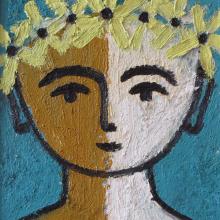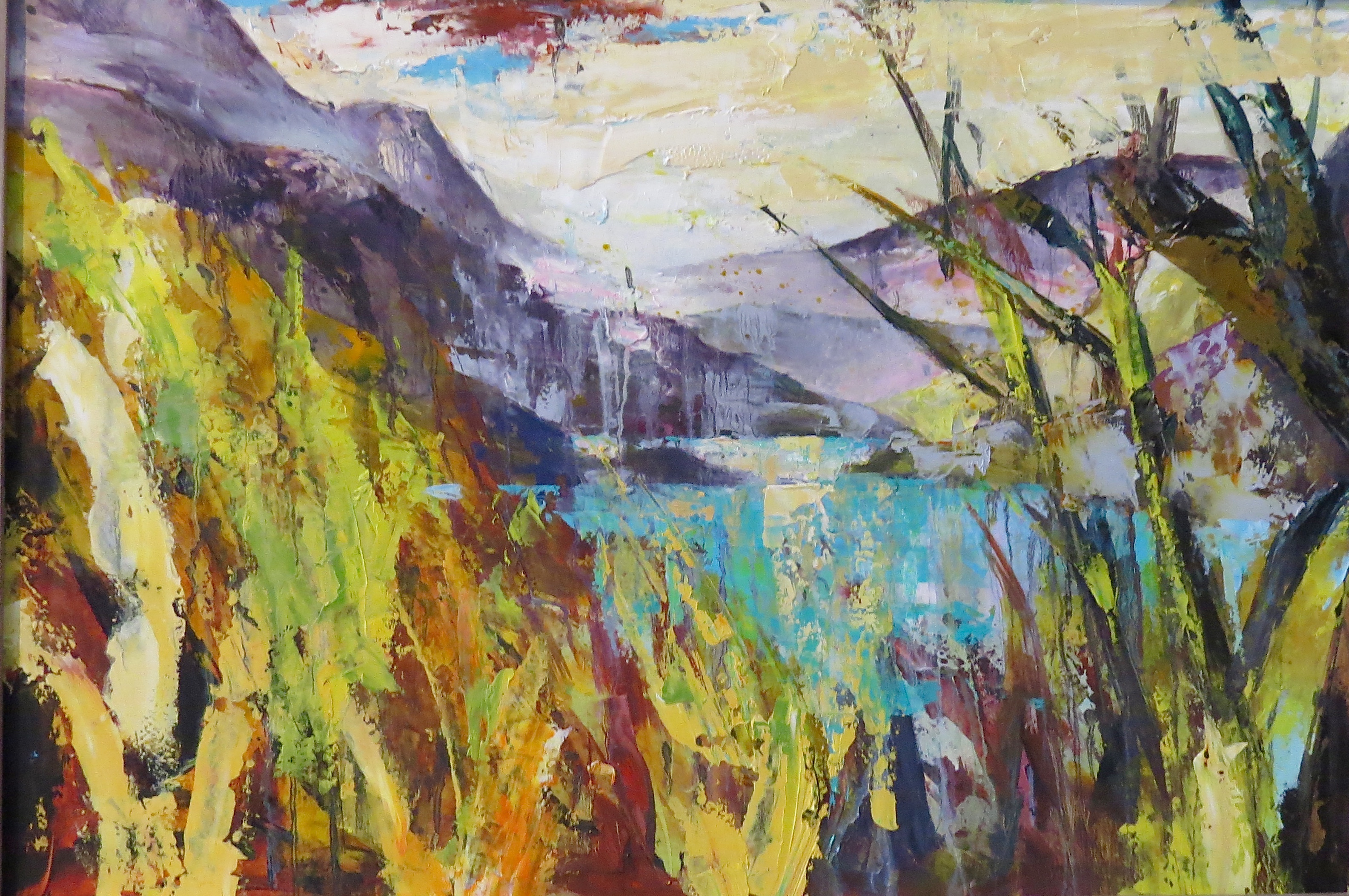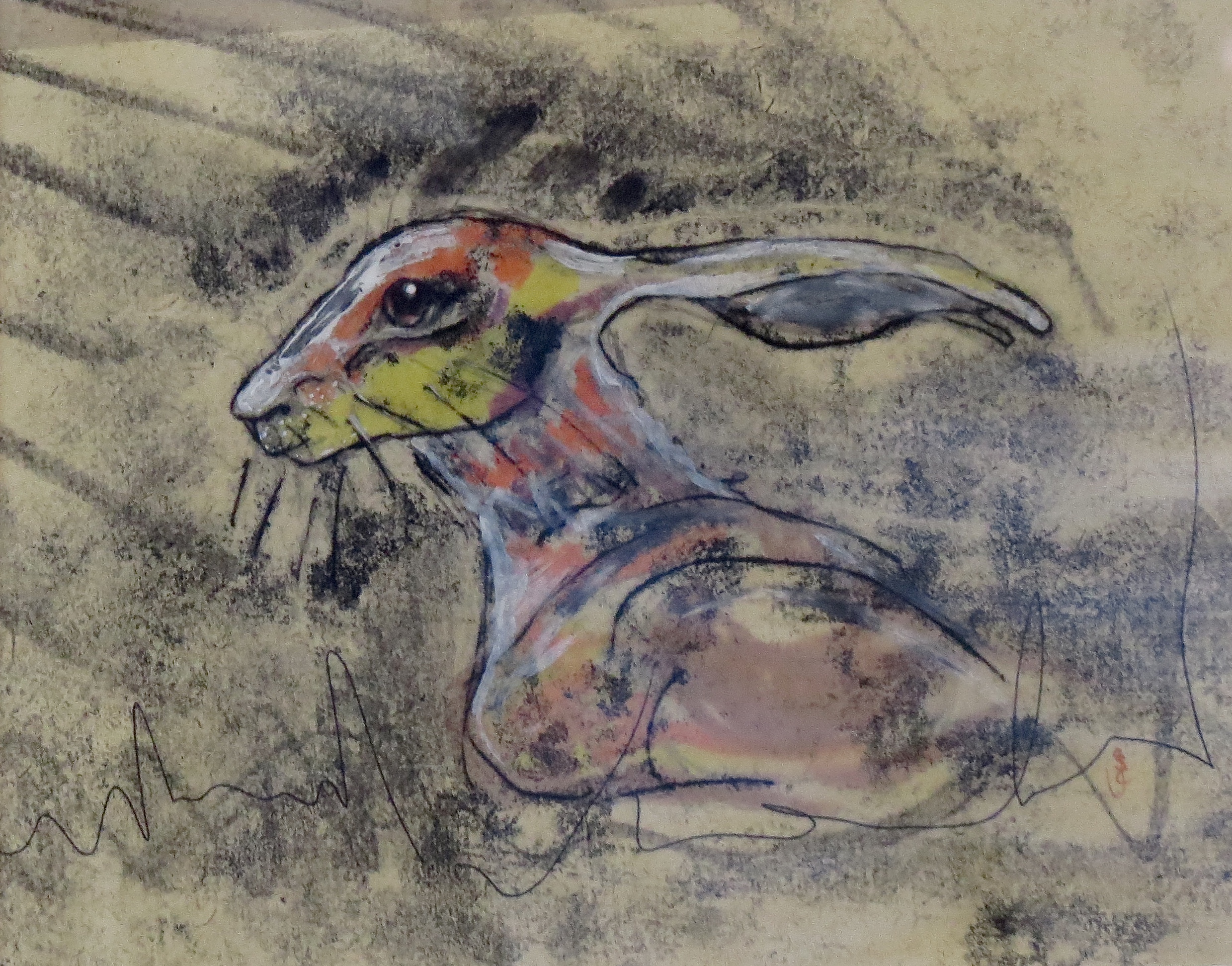
A new joint exhibition opened this morning in the White Space Gallery outstation on Howe Street.
It features the work of nine artists, showing together for the first time. They come from all over the country, although there are strong connections among them to Edinburgh and the thriving art scene in Ullapool.
Perhaps the most well known is Adam King, who has exhibited frequently since the late 1980s, particularly in his native Yorkshire.
His oils here comprise an alternative take on the Scarborough seaside, with ‘Whiteline Girl with Flowers’ (above) and ‘Fishermen’ (below) standing out.

Barbara Anne Goodchild draws inspiration from ‘the decay and erosion of the natural environment, as well as skeletal architectural remains and ruins’.
Sure enough, her ‘Untitled Frottage 1’ is an intriguing blend of organic textures, Chinese mountainscape, and post-apocalyptic disjunction. The slightly odd angle of the photo below (and others on this page) derives from this reviewer’s effort to avoid reflections, not an attack of vertigo.
Decay is evident also in Emily Stewart’s arresting ‘African Buffalo Skull’. Energetically rendered in acrylic, wax, oil and chalk pastel, it’s not the cheeriest of paintings but is difficult to ignore, even though displayed at ground level.
Visiting Ullapool, one is forcibly reminded that nearly three-quarters of the Earth’s surface is covered in water, and that most of it will descend on Broomfield Holiday Park in an average hour.
Janis Breckenridge ‘finds the sudden energy of squalls invigorating’, and enjoys the ‘uplifting’ power of a strong wind. She also relishes the nice distinctions of Gaelic words to describe the weather, and finds in them emotional corollaries. ‘Frasan’, the title of the colagraph below, means showers.
Interestingly, this reviewer’s exhaustive online search revealed no Gaelic word for heatstroke.

From the travails of the northern climate to the tranquility of Neil Sutherland’s beautiful images. His ‘Symbol 1’ was a highlight among several wonderfully observed and composed inkjet prints. Strong too were the subtly graduated tones of his photogravures.

Elspeth Milnes is another Yorkshire-based artist, but she spent much of last winter in Scotland’s North-West and shares Breckenridge’s taste for wild weather.
Starting with sketches and photographs of her favoured vast panoramas, she works these up later in the studio using a loose style and free-handling of paint. The results can be spectacularly effective, as in her oil on paper ‘Loch Broome’.

I have always liked hares. I like their peculiar cat-like lankiness and the unmistakable glint of intelligence in their eyes. It should therefore come as no surprise that Sara Garnett’s paired portraits – ‘Dawn Hare’ (below) and ‘Dusk Hare’ – appealed greatly.
Much of Garnett’s work is inspired by the flora and fauna around her home in Assynt.

Jane Worthington’s style is quite different to anything else in the exhibition. ‘Noëtic’ – meaning purely intellectual or abstract – is the term she uses to describe her approach, although she also alludes to her inherited synaesthesia and interest in the universe as sources of inspiration.
I found her oil ‘Noësis 13679’ particularly enjoyable: a mysterious yet satisfying exploration of form and colour.

In Patricia B. Gulliver’s ‘Snow Fences 2’ we return to the black and white realities of the Scottish climate. Thickly applied acrylic, ink and wax render this painting pleasingly three-dimensional.

Finally we come to the work of Patricia Methven. Originally from Edinburgh, she has lived and worked in the Highlands for many years, gradually accruing an admiration for the inhabitants of lost communities based in some of the remotest and most difficult environments.
More recently, she felt it important that ‘the hardship endured by successive generations living on the edge, should be remembered and considered by current generations’.
The results – mostly in acrylic/mixed media with ink drawing and printing – are stark, pared down imaginings of lives played out against mountainous odds. For all their large scale, they have a mythic, folkloric simplicity which I found entirely beguiling.
Below are first ‘Lofoten’ and then ‘Cruck Barn’.


Free and Radical continues at White Space, 25 Howe Street until 22 October (10.30am–6.00pm, Saturday–Wednesday; 10.30am–4.00pm, Thursday) —AM.